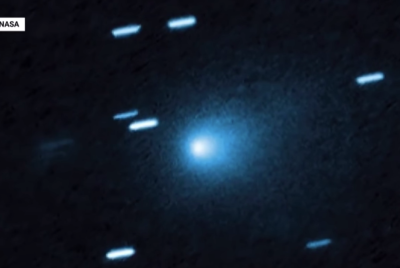3I/ATLAS Radio Signal Proves Interstellar Comet Is Definitely Not an Alien - Here's the Proof
The detected frequencies matched hydroxyl molecules, a common byproduct of sunlight reacting with water vapour in comets

Astronomers have confirmed that the mysterious radio signals detected from the interstellar object 3I/ATLAS are natural in origin, ending weeks of speculation that it could be an alien spacecraft. The discovery, made using the MeerKAT radio telescope array in South Africa, initially caused a stir when the object appeared to emit a distinct radio pattern not seen before in interstellar visitors.
For a short time, theories spread across social media that 3I/ATLAS might be a probe sent by another civilisation. The claims were fuelled by comparisons to 2017's Oumuamua, another interstellar object once suspected by some to be artificial. Scientists, however, urged caution from the start, noting that the signal was most likely caused by a natural chemical process rather than technology.
Fresh analysis of the data has now confirmed that the emissions match well-known signs of cometary outgassing. The new findings mean that 3I/ATLAS behaves exactly like a comet made of ice and dust, not a craft powered by intelligent design.
The Signal That Started the Speculation
The MeerKAT telescope recorded faint radio absorption lines at 1.665 and 1.667 gigahertz on 24 October 2025, just after 3I/ATLAS reappeared from behind the Sun. These frequencies correspond to hydroxyl radicals, or OH molecules, which form when sunlight breaks apart water vapour in a comet's surrounding cloud, known as the coma.
This reaction is a familiar signature in active comets, particularly those nearing the Sun, and has been documented in dozens of previous cases. Despite that, the discovery led to a flurry of online discussion suggesting that the object might be transmitting a signal. Astronomers quickly clarified that the observed frequencies reflected molecular absorption, not an intentional broadcast from an intelligent source.
Why the Evidence Points to a Natural Object
The behaviour of 3I/ATLAS is consistent with that of a typical comet. It has a visible coma and tail that respond to solar radiation, and its radio profile mirrors the outgassing seen in icy bodies throughout the Solar System. Its trajectory is also strongly hyperbolic, confirming it originated beyond the Sun's gravitational influence, yet shows no sign of deliberate manoeuvring or propulsion.
Experts now widely agree that the object's features can be fully explained through natural processes. As one planetary scientist told The Guardian, 'It looks like a comet and it behaves like a comet. There is no reason to think it is something else.'
Why the Alien Theory Persisted
The 'alien probe' theory persisted in part due to comments from Harvard astrophysicist Avi Loeb, who suggested the object's high carbon dioxide-to-water ratio and unusual light polarisation could hint at something engineered. These findings were unusual, but astronomers emphasise that 'anomalous' simply means different from most comets, not artificial.
Researchers still hope to understand why 3I/ATLAS contains so much carbon dioxide and how its dust particles scatter light in unexpected ways. Those open questions make it a scientifically valuable object, though none require an extraterrestrial explanation.
🚨 3I/ATLAS SURVIVED THE SUN — AND IT’S STILL ONE PIECE ☄️
— Astronomy Vibes (@AstronomyVibes) November 13, 2025
Something unbelievable just happened in space. The mysterious interstellar object 3I/ATLAS, which many thought had exploded near the Sun, has defied all expectations — it’s still completely intact.
Fresh images taken on… pic.twitter.com/FhGBpmEA8j
1) 3I/ATLAS goes behind the Sun
— DeanLøgic ♎ (@DeanLogic) November 12, 2025
2) It loses 13% of its mass
3) We have 3 large CME shoot towards Earth to create a "Cannibal CME"
Everything is fine. pic.twitter.com/uDq6lV3En3
The Verdict on 3I/ATLAS
The radio detection from 3I/ATLAS once reignited speculation about a hidden alien craft. Subsequent analysis has shown that the signals are best explained by familiar cometary chemistry. The object continues to offer rare insight into material from beyond our Solar System, helping scientists refine how interstellar comets behave and evolve.
While questions remain about its precise composition, researchers say there is no evidence to suggest an artificial origin. For now, 3I/ATLAS is regarded as a scientifically valuable visitor from another star system rather than anything more extraordinary.
© Copyright IBTimes 2025. All rights reserved.





















